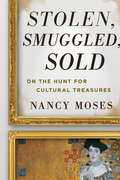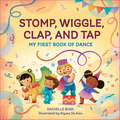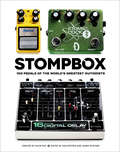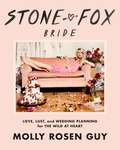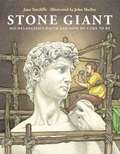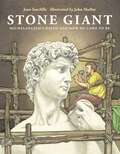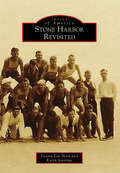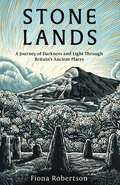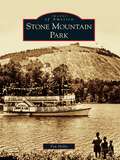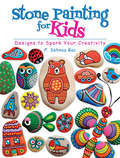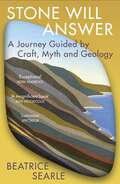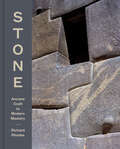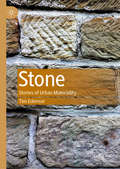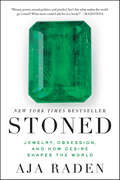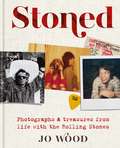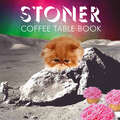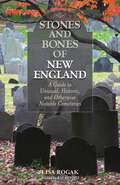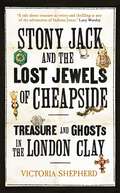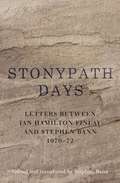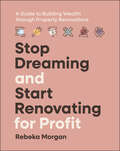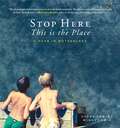- Table View
- List View
Stolen, Smuggled, Sold: On the Hunt for Cultural Treasures
by Nancy Moses&“A riveting look at the backstory of what&’s in the display cases at your local museum. The author profiles seven historic objects with checkered pasts.&” —Library Journal There are many books about museum heists, Holocaust artwork, insider theft, trafficking in antiquities, and stolen Native American objects. Now, there&’s finally a book for the general public that covers the entire terrain. Stolen, Smuggled, Sold features seven vivid and true stories in which the reader joins the author as she uncovers a cultural treasure and follows its often-convoluted trail. Along the way author and reader encounter a cast of fascinating characters from the underbelly of the cultural world: unscrupulous grave robbers, sinister middlemen, ruthless art dealers, venal Nazis, canny lawyers, valiant academics, unstoppable investigative reporters, unwitting curators, and dedicated government officials. Stories include Gustav Klimt&’s Portrait of Adele Bloch Bauer 1, the typset manuscript for Pearl Buck&’s The Good Earth, a ceremonial Ghost Dance shirt from the massacre at Wounded Knee, the theft of 4,800 historical audio discs by a top official at the National Archives, a missing original copy of The Bill of Rights, the mummy of Ramses I, and an ancient treasure from Iraq. While each story is fascinating in and of itself, together they address one of the hottest issues in the museum world: how to deal with the millions of items that have breaks in the chain of ownership, suspicious ownership records, or no provenance at all. The issue of ownership touches on professional practices, international protocols, and national laws. It&’s a financial issue since the illicit trade in antiquities and cultural items generates as much as $4 billion to $8 billion a year.
Stomp, Wiggle, Clap, and Tap: My First Book of Dance
by Rachelle BurkShake, rattle, and roll with this delightful dance book for children ages 1-3Toddlers are natural dancers, and they love to move! Release some of that endless toddler energy and help them develop balance and coordination with Stomp, Wiggle, Clap, and Tap. Moving along with the story will help stimulate little brains and provide a fun, creative way to build spatial awareness. Tons of colorful pictures offer toddlers visual clues for the movements, and the rhyming words make reading aloud feel like music.Movement and motor skills—Little ones will begin by learning to isolate individual body parts, like their hands, hips, arms, and toes, then move their whole body.Dynamic dancing—Toddlers will harness their imagination when they dance with silly moves like Prancing Pony, Flapping Chicken, and Twirling Pinwheel.Keep the fun going—Explore a list of online dance videos and resources to help them keep moving and developing even when the book is finished.Set the stage for an active childhood with this standout in books for toddlers.
Stompbox: 100 Pedals of the World's Greatest Guitarists
by Eilon PazA deluxe photographic celebration of the unsung hero of guitar music—the effects pedal—featuring interviews with 100 musicians including Peter Frampton, Joe Perry, Jack White, and Courtney Barnett.Ever since the Sixties, fuzz boxes, wah-wahs, phase shifters, and a vast range of guitar effects pedals have shaped the sound of music as we know it.Stompbox: 100 Pedals of the World&’s Greatest Guitarists is a photographic showcase of the actual effects pedals owned and used by Jimi Hendrix, Stevie Ray Vaughan, Frank Zappa, Alex Lifeson, Andy Summers, Eric Johnson, Adrian Belew, Joe Satriani, Steve Vai, Ed O&’Brien, J Mascis, Lita Ford, Joe Perry, Thurston Moore, Lee Ranaldo, Vernon Reid, Kaki King, Nels Cline and 82 other iconic and celebrated guitarists.These exquisitely textured fine-art photographs are matched with fresh, insightful commentary and colorfulroad stories from the artists themselves, who describe how these fascinating and often devilish devices shaped their sounds and songs.
Stone Fox Bride: Love, Lust, and Wedding Planning for the Wild at Heart
by Molly Rosen GuyDitch the storybook wedding, banish Bridezilla, and walk down the aisle in truth and in style: You are a Stone Fox Bride and this is your bridal guide.Molly Rosen Guy founded the brand Stone Fox Bride as an alternative to outdated, plastic-princess wedding culture. Her stylish and subversive approach is being embraced by creative, modern brides who believe in love and romance, but have no interest in running off into the sunset. In an inspiring mix of intimate storytelling, gorgeous visuals, and candid advice, with an aesthetic that channels Bianca Jagger in a white tux rather than Cinderella in a frilly gown, Molly Rosen Guy—your cool, hippie chic guide through the wilds of wedding planning—encourages brides-to-be, and their ladies in tow, to say no to all things phony, frilly, and silly. Featuring personal essays that explore the nuances of the process, including a raw, unairbrushed look at the realities of the early days of marriage, she tells us that a Stone Fox Bride should never sacrifice her style, her story, or her sanity to please others; she reassures us that weddings don't have to be free of confusion, shades of gray, or cellulite; and reminds us that marriage, like love, is equal parts complicated and beautiful.Praise for Molly Rosen Guy and the Stone Fox Bride phenomenon “The current wedding-wear darling of the jammin’ and Instagrammin’ set [offers] an insouciant, antiestablishment approach to weddings.”—The New York Times “[Molly Rosen Guy is] making waves in the bridal industry thanks to her eclectic eye and refusal to conform to clichéd traditions.”—W“Molly Rosen Guy built a business filling the needs of women who long for something more than your run-of-the-mill, princess-y flou for their big day.”—Vogue
Stone Giant: Michelangelo's David and How He Came to Be
by Jane SutcliffeMichelangelo saw something—someone—special in the stone. <P><P>No one wanted the “giant.” The hulking block of marble lay in the work yard, rained on, hacked at, and abandoned—until a young Michelangelo saw his David in it. <P><P>Night and day, Michelangelo worked in secret, lovingly coaxing statue out of the stone. Its majesty endures even today. <P><P>This is the story of how a neglected, discarded stone became a masterpiece for all time. It is also a story of how humans see themselves reflected in art. <P><P>Back matter includes further information about David and a selected bibliography <P><P>Lexile Measure: 610L
Stone Giant: Michelangelo's David and How He Came to Be
by Jane SutcliffeMichelangelo saw something—someone—special in the stone. No one wanted the &“giant.&” The hulking block of marble lay in the work yard, rained on, hacked at, and abandoned—until a young Michelangelo saw his David in it.Night and day, Michelangelo worked in secret, lovingly coaxing statue out of the stone. Its majesty endures even today. This is the story of how a neglected, discarded stone became a masterpiece for all time. It is also a story of how humans see themselves reflected in art. Back matter includes further information about David and a selected bibliography
Stone Harbor Revisited (Images of America)
by Karen Jennings Donna Van HornIn 1722, Seven Mile Beach, covered in red cedar and holly, bayberry bushes and beach plums, was acquired by the Leaming family, who used it for grazing and whaling. Long undeveloped, the southern portion of the island was sold to the South Jersey Realty Company in 1907. The Risley brothers sold bonds to support their vision of a seaside resort serving the wealthy of Philadelphia. Dunes were leveled, roads laid out, and basins dredged, creating the ideal vacation destination. Grand hotels shared space with workmen's cottages, and businesses sprang up to serve the crowds who flocked to Stone Harbor. The maritime ties of the community are evident in the long history of the Yacht Club of Stone Harbor, which traces its beginnings to as early as 1895. The clubhouse, built in 1909 and standing on its original site, is host to sailing and social activities throughout the year.
Stone Lands: A Journey of Darkness and Light Through Britain’s Ancient Places
by Fiona Robertson'Superb' Telegraph'There's a real sense of peace and magic in this beautiful book' Daisy Buchanan'Utterly endearing' Dr James Canton'A fantastic book for weird walkers and megalith-obsessives alike' Weird Walk 'I was alternately gripped and moved to tears by this brilliant, exquisite memoir. . . I can't recommend it enough' Harriet EvansJourneying across Britain, from West Penwith and Avebury to the Lake District and Orkney, Stone Lands uncovers the magic and rich history of our incredible prehistoric standing stones. It conveys the delight that lies in tracking them down, as well as the solace these ancient places offer in times of darkness.A few months after discovering that her beloved husband, Stephen, had incurable cancer, Fiona Robertson began to write this book. A long-time megalith enthusiast, she found the ancient stones resonated with her more profoundly than ever as she faced the prospect of losing him. Set upright thousands of years ago, the megaliths are symbols of endurance and survival, standing in contrast to our ephemeral human lives. Infused with folklore, legend and mystery, they enchant the landscape and bring magic to our modern world. This enthralling memoir is woven delicately around great grief but is ultimately about embracing life, joy and ancient wonder - a luminous reminder of what it means to exist on this earth.Stone Lands is beautifully illustrated inside with stunning black and white line drawings by the illustrator and printmaker Philip Harris. Find out more about his work: www.philipharrisillustration.com'A reminder that the ancient stones can be sources of reassurance and solidity, even in our times of greatest upheaval and loss' Angeline Morrison'A very, very good read ... this is one to treasure' Blackwell'sStone Lands is 'assiduously researched, full of anecdotes and makes you look anew at these enduring landmarks' Country Life
Stone Lands: A Journey of Darkness and Light Through Britain’s Ancient Places
by Fiona Robertson'Superb' Telegraph'There's a real sense of peace and magic in this beautiful book' Daisy Buchanan'Utterly endearing' Dr James Canton'A fantastic book for weird walkers and megalith-obsessives alike' Weird WalkJourneying across Britain, from West Penwith and Avebury to the Lake District and Orkney, Stone Lands uncovers the magic and rich history of our incredible prehistoric standing stones. It conveys the delight that lies in tracking them down, as well as the solace these ancient places offer in times of darkness.A few months after discovering that her beloved husband, Stephen, had incurable cancer, Fiona Robertson began to write this book. A long-time megalith enthusiast, she found the ancient stones resonated with her more profoundly than ever as she faced the prospect of losing him. Set upright thousands of years ago, the megaliths are symbols of endurance and survival, standing in contrast to our ephemeral human lives. Infused with folklore, legend and mystery, they enchant the landscape and bring magic to our modern world. This enthralling memoir is woven delicately around great grief but is ultimately about embracing life, joy and ancient wonder - a luminous reminder of what it means to exist on this earth.Stone Lands is beautifully illustrated inside with stunning black and white line drawings by the illustrator and printmaker Philip Harris. Find out more about his work: www.philipharrisillustration.com'A reminder that the ancient stones can be sources of reassurance and solidity, even in our times of greatest upheaval and loss' Angeline Morrison
Stone Lands: A Journey of Darkness and Light Through Britain’s Ancient Places
by Fiona Robertson'Superb' Telegraph'There's a real sense of peace and magic in this beautiful book' Daisy Buchanan'Utterly endearing' Dr James Canton'A fantastic book for weird walkers and megalith-obsessives alike' Weird WalkJourneying across Britain, from West Penwith and Avebury to the Lake District and Orkney, Stone Lands uncovers the magic and rich history of our incredible prehistoric standing stones. It conveys the delight that lies in tracking them down, as well as the solace these ancient places offer in times of darkness.A few months after discovering that her beloved husband, Stephen, had incurable cancer, Fiona Robertson began to write this book. A long-time megalith enthusiast, she found the ancient stones resonated with her more profoundly than ever as she faced the prospect of losing him. Set upright thousands of years ago, the megaliths are symbols of endurance and survival, standing in contrast to our ephemeral human lives. Infused with folklore, legend and mystery, they enchant the landscape and bring magic to our modern world. This enthralling memoir is woven delicately around great grief but is ultimately about embracing life, joy and ancient wonder - a luminous reminder of what it means to exist on this earth.Stone Lands is beautifully illustrated inside with stunning black and white line drawings by the illustrator and printmaker Philip Harris. Find out more about his work: www.philipharrisillustration.com'A reminder that the ancient stones can be sources of reassurance and solidity, even in our times of greatest upheaval and loss' Angeline Morrison
Stone Mountain Park
by Tim HollisFor centuries, explorers and pioneers told of a place in Georgia where there was a gigantic mountain of solid granite resembling "a great gray egg lying half-buried on a vast plain." In time, Stone Mountain, 15 miles east of Atlanta, became a local landmark. In 1915, it was decided that the mountain's sheer north face would be a good spot to carve a lasting memorial to the lost cause of the Confederacy. This proved to be easier said than done. Before the project was completed, one of Georgia's top tourist attractions was established around Stone Mountain's base.
Stone Painting for Kids: Designs to Spark Your Creativity
by F. Sehnaz BacThis follow-up to the bestselling Art of Stone Painting offers a kid-friendly version of an engaging activity that helps promote creativity. Popular stone artist F. Sehnaz Bac, a seasoned archaeologist who markets her painted Sassi dell’Adriatico (Stones of the Adriatic) on Etsy, presents step-by-step instructions for simple projects, accompanied by full-color photographs. Her introduction explains how to find and choose stones, which kinds of materials and tools are safe for kids to use, how to set up a workspace, simple techniques, and other helpful tips.A splendid variety of patterns begins with illustrations of basic shapes and designs for human figures and faces, animals, numbers and letters, and natural motifs—flowers, trees, and stars. Other activities include painting stones for games such as tic-tac-toe, chess, and dominoes. Kids will learn lettering techniques for writing names and words on pebbles and how to design holiday-themed decorations. They'll also discover how to assemble multiple stones for picture-making and story-telling.
Stone Will Answer: A Journey Guided by Craft, Myth and Geology
by Beatrice SearleA beautiful memoir, travelogue and meditation on stone by artist and stone mason Beatrice Searle.'Extraordinary' Guardian‘A magnificent book’ Alex Woodcock‘Exceptional’ Kerri Andrews‘Luminous’ SpectatorAt the age of twenty-six, artist and Cathedral stonemason Beatrice Searle crossed the North Sea and walked 500 miles along a medieval pilgrim path through Southern Norway, taking with her a 40-kilogram Orcadian stone.Fascinated with the mysterious footprint stones of Northern Europe and the ancient Greco-Roman world, stones closely associated with travellers, saints and the inauguration of Kings, she follows in their footsteps as her stone becomes a talisman, a bedrock and an offering to those she meets along the way.Stone Will Answer is an unusual adventure story of journeys practical, spiritual and geological, of weight and motion, and an insight into a beguiling craft.
Stone: Ancient Craft to Modern Mastery
by Richard RhodesIn this perceptive and illustrative look at the expressive and practical use of stone throughout history, Richard Rhodes unlocks the underlying principles of this ancient material—and explains the closely guarded “Sacred Rules” of the Freemasons guild for the first time ever.The relationship between mankind and stone is elemental and deeply ingrained in us all. Stone, after all, has been the primary building material for more than five thousand years of human history, and it continues to record our triumphs and failures. In this searching history, Rhodes—a sculptor, stonemason, and scholar of stonework—explores how stone is best used today and throughout history. Stone presents the closely kept “Sacred Rules” developed over centuries by the medieval Freemason guild, previously available only to the initiated. Here, the rules are explained through historical examples and photographs. In these times of rapid development and expansive urbanization, Rhodes implores us to explore the essential qualities of stone that emerge from the Sacred Rules, not only to rediscover the ancient and traditional knowledge that governed its use for so long but also to find a roadmap for how future generations might thoughtfully recapture the power this material offers.MOST RENOWNED STONEMASON IN THE U.S.: Richard Rhodes apprenticed as a stonemason in Siena, Italy, after graduate studies at the London Academy of Music and Dramatic Art. As the first non-Italian admitted into Siena’s ancient masonic guild in 726 years, he is known throughout the sculpture and stone community as the “last apprentice.” HISTORICAL EDUCATION: A nationally acclaimed lecturer and educator, Rhodes has shared his deep knowledge of the history of stone and stonemasonry through convention addresses to the American Institute of Architects and the Association of Professional Landscape Designers, a five-lecture educational series to the Institute of Classical Architecture in both New York and San Francisco, and lectures to the Building Stone Institute and many public and private universities. His work has been featured in Architectural Digest, New York Times, Architectural Record, MSNBC, The Globe and Mail, Greenwich Post, Seattle Times, and The Globe and Mail, among many others. EXPERT CONTRIBUTOR: The book includes a foreword by Paul Goldberger, a contributing editor at Vanity Fair and previous architecture critic for both the New Yorker and the New York Times, where he was awarded the Pulitzer Prize. He is the author of many books, including Why Architecture Matters.
Stone: Stories of Urban Materiality
by Tim EdensorIn undertaking a systematic analysis of urban materiality, this book investigates one kind of material in Melbourne: stone. The work draws on a range of pertinent, current theories that consider materiality, assemblages, networks, phenomenology, resource and extraction geographies, memorialisation, maintenance and repair, place identity, skill, sensation and affect, haunting and the vitalism of the non-human. In appealing to the general reader, academics and students, this book provides a highly readable account, replete with evocative examples and fascinating historical and contemporary stories about stone in Melbourne.
Stoned: Jewelry, Obsession, and How Desire Shapes the World
by Aja RadenAs entertaining as it is incisive, Stoned is a raucous journey through the history of human desire for what is rare, and therefore precious.What makes a stone a jewel? What makes a jewel priceless? And why do we covet beautiful things? In this brilliant account of how eight jewels shaped the course of history, jeweler and scientist Aja Raden tells an original and often startling story about our unshakeable addiction to beauty and the darker side of human desire.What moves the world is what moves each of us: desire. Jewelry—which has long served as a stand-in for wealth and power, glamor and success—has birthed cultural movements, launched political dynasties, and started wars. Masterfully weaving together pop science and history, Stoned breaks history into three categories—Want, Take, and Have—and explains what the diamond on your finger has to do with the GI Bill, why green-tinted jewelry has been exalted by so many cultures, why the glass beads that bought Manhattan for the Dutch were initially considered a fair trade, and how the French Revolution started over a coveted necklace.Studded with lively personalities and fascinating details, Stoned tells the remarkable story of our abiding desire for the rare and extraordinary.
Stoned: Photographs and treasures from life with the Rolling Stones
by Jo Wood"These images are great and have been tucked away for years"RONNIE WOOD "The REAL Rolling Stones... Consider this your AAA pass to touring with Mick 'n' Keith 'n' co."THE SUNDAY TELEGRAPH Take a look inside rock 'n' roll history with over 500 never-before-seen photographs, notes, artworks, diary entries and mementoes from life behind the scenes of the Rolling Stones.Married to legendary Stones guitarist Ronnie Wood for 30 years, Jo Wood lived the rock star life. Her incredible collection of treasures from that time is a once-in-a-lifetime look inside the biggest band in the world.Accompanied by personal memories and behind the scenes anecdotes from Jo, Stoned is a love letter to the rock 'n' roll life and a truly unique window into the eye of the Rolling Stones hurricane.
Stoned: Photographs and treasures from life with the Rolling Stones
by Jo Wood"These images are great and have been tucked away for years"RONNIE WOOD "The REAL Rolling Stones... Consider this your AAA pass to touring with Mick 'n' Keith 'n' co."THE SUNDAY TELEGRAPH Take a look inside rock 'n' roll history with over 500 never-before-seen photographs, notes, artworks, diary entries and mementoes from life behind the scenes of the Rolling Stones.Married to legendary Stones guitarist Ronnie Wood for 30 years, Jo Wood lived the rock star life. Her incredible collection of treasures from that time is a once-in-a-lifetime look inside the biggest band in the world.Accompanied by personal memories and behind the scenes anecdotes from Jo, Stoned is a love letter to the rock 'n' roll life and a truly unique window into the eye of the Rolling Stones hurricane.
Stoner Coffee Table Book
by Steve MockusHave you ever really looked at a book? The state of being high rewards deep attention, and lots of things can seem really, really interesting. It might be a spot on the ceiling, or an oddly-shaped tortilla chip, or a bit of wood grain. But why settle for staring at the coffee table? What if there was a book on that table specially created to amaze and delight pot smokers and their friends? This highly entertaining collection of images is the ultimate centerpiece and conversation starter. Featuring dozens of immersive, trippy, funny, meditative, and mind-bending images, each page offers a new visual world of wonder that everyone can enjoy especially those living the high life
Stones and Bones of New England: A Guide To Unusual, Historic, and Otherwise Notable Cemeteries
by Lisa RogakWhether it's for their solace and beauty or for the sense of history that seeps from the ground, cemeteries are fascinating places to visit, this guide shows where to find the most interesting and unusual ones in all of New England. Some have headstones that are fine art, others are associated with notorious events, and others are the final resting place of famous poets, soldiers, and statesmen. Included are large public facilities as well as the small family burying grounds hidden away behind crumbling stone walls and along once-cultivated farmland. A sampling of cemeteries profiled:*Hope Cemetery in Barre, Vermont, where lifelike sculptures of angels and Greek goddesses stand next to a stone soccer ball and Shell Oil truck gravemarker, all elaborately carved from local granite by immigrant Italian stonecutters. *Spider Gates Cemetery, in Leicester, Massachusetts, a notorious Quaker burying ground famed for its frequent ghost sightings and still in use today.*A cemetery situated on the raised median of the Interstate in Warner, New Hampshire,which was preserved in 1970 by highway planners, who constructed the roadway around it.*Evergreen Cemetery in New Haven, Vermont, final resting place of Timothy Clark Smith, whose 1893 crypt includes a window to help him escape in case he was buried alive.Driving directions are provided for each cemetery, and detailed maps show the location of the more obscure graveyards. This unique guide offers an intriguing way to learn about the history and culture of New England.
Stony Jack and the Lost Jewels of Cheapside: Treasure and Ghosts in the London Clay
by Victoria ShepherdA thrilling history of mudlarkers, charlatans, experts and chancers – the underbelly of the Edwardian antiques trade. 'What a story! And how skilfully told! A tale about treasure, as twisty and thrilling as any of the adventures of Indiana Jones.' Lucy Worsley June 1912. A pair of workmen deposit a heavy ball of clay in the antiques shop of George Fabian Lawrence, or &‘Stony Jack&’ as he's better known. As Lawrence picks through the mud, a speck of gold catches his eye. A pearl earring tumbles into his hand, then another. A Burmese ruby follows; then Colombian emeralds, lapis lazuli from Afghanistan and turquoise from Iran; tankards; watches; topaz; amazonite. Stony Jack has discovered the greatest single cache of Elizabethan treasure. Diving into London&’s bustling, sometimes lawless, antiques trade at the turn of the century, Victoria Shepherd provides a compelling portrait of the city at the height of empire. A thrilling ride through Edwardian London, from the marble halls of the British Museum to the East End's maze of tenements and alleyways, Stony Jack and the Lost Jewels of Cheapside oversees the transformation of the city into a modern metropolis.
Stonypath Days: Letters between Ian Hamilton Finlay and Stephen Bann 1970-72
by Stephen Bann Ian Hamilton FinlayThese letters to (and from) Finlay's friend, the English poet and scholar, Stephen Bann, centre on the initial development of the garden at Stonypath, near Edinburgh, later to become the world renowned 'Little Sparta'. They cover Finlay's turn away from poetry towards sculpture and garden design, and the thinking behind, and consequences of, this development.
Stop Dreaming and Start Renovating for Profit: A Guide to Building Wealth through Property Renovations
by Rebeka MorganTurn your passion for renovating and home design into profit Do you love the idea of renovating and flipping houses, but you’re scared to take the plunge? Stop Dreaming and Start Renovating for Profit is an inspiring, practical how-to guide for creating financial independence by renovating and reselling residential properties. Registered builder and successful developer Rebeka Morgan has helped thousands of women buy, renovate and sell properties for profit. In this book, she shares her tried-and-tested advice for harnessing your unique strengths to strategically improve a property’s value — and build your wealth quickly. You’ll grow your skills as a planner, decision maker and developer, learning how to be creative and find the gains that add up to thousands of dollars in profit. And you’ll discover how renovating can be a flexible, profitable business that fits into your busy life. Whether you’re caring for your family, rethinking your career or simply looking to boost your income, this book will empower you to take action and grow your earnings. Inside, you’ll find: Practical tools and case studies to help you see the big picture, find your vision and seize the courage to get started Strategies for analysing feasibility and designing profitable projects Hands-on, step-by-step guidance for managing the design and build process Advice that will help you avoid time-consuming and costly mistakes Tips for marketing and selling your property once the renovations are done Renovating property is not a guaranteed shortcut to quick profits. Getting a return on your investment is about seeing a home’s potential and then taking smart steps to realise that potential. Whether you’re just getting started or you’re looking to build a business flipping homes, Stop Dreaming and Start Renovating for Profit is a can’t-miss resource.
Stop Here, This is the Place
by Susan ConleyWinky Lewis and Susan Conley, a photographer and a writer in Portland, tried an experiment. At the startof every week for a year, Winky sent Susan a photograph: of their children, of the street where they liveas neighbors, and of other green places in Maine. By the end of that week Susan sent a tiny story backthat talked to the photograph. Stop Here, This Is The Place tells the story of a year in which children'sarms and legs get longer, and traces of babyhood fade--a year that feels interminable to a ten-year-oldlooking forward and fleeting to that ten-year-old&’s mother, who can always stop here, go back andremember. This delightfully evocative gift book is a reminder to stop and enjoy the precioustime we have with our kids while we have them. Through Susan's recollections of moments from her childhood and the ongoing lives of her children, we&’re reminded of our own childhoods, and of the necessity to stop and pay attention, to hold on.
Stop Look Breathe Create
by Wendy Ann Greenhalghh3>Stop Look Breathe Create is a simple four-step process for exploring mindfulness through creativity, and in turn, developing creativity through mindful practice.The book engages the reader with ten everyday subjects, from 'The Ground Beneath Our Feet' to 'Returning Home' and for each of these there are three projects: one drawn, one photographic, one written. All are based on the effective mindfulness techniques that Wendy Ann has developed in her successful workshops and courses, and the book is filled with simple techniques and ideas to help the reader enjoy their artistic endeavours while being in the moment.A timely introduction to the benefits of mindfulness through creativity, Stop Look Breathe Create offers an oasis of calm in a frantic world.
